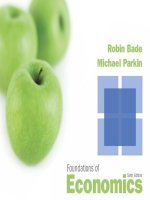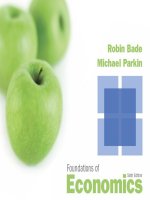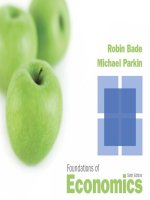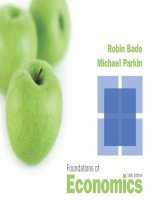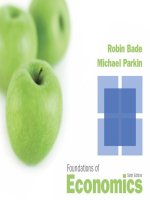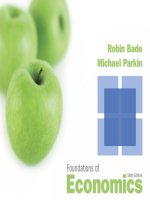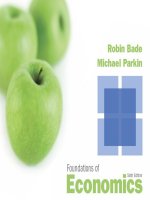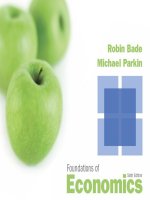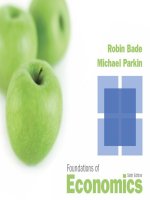Foundaions of economics 6th by robin bade ch05
Bạn đang xem bản rút gọn của tài liệu. Xem và tải ngay bản đầy đủ của tài liệu tại đây (1.32 MB, 59 trang )
© 2013 Pearson
What do you do when the price
of gasoline rises?
© 2013 Pearson
5
Elasticities of
Demand and Supply
CHAPTER CHECKLIST
When you have completed your
study of this chapter, you will be able to
1 Define the price elasticity of demand, and explain the
factors that influence it and how to calculate it.
2 Define the price elasticity of supply, explain the factors
that influence it and how to calculate it.
3 Define the cross elasticity of demand and the income
elasticity of demand, and and explain the factors that
influence them.
© 2013 Pearson
5.1 THE PRICE ELASTICITY OF DEMAND
Price elasticity of demand is a measure of
the extent to which the quantity demanded of a
good changes when the price of the good
changes.
To determine the price elasticity of demand, we
compare the percentage change in the quantity
demanded with the percentage change in price.
© 2013 Pearson
5.1 THE PRICE ELASTICITY OF DEMAND
Percentage Change in Price
Suppose Starbucks raises the price of a latte from $3 to $5
a cup. What is the percentage change in price?
Percent change in price =
Percent change in price =
© 2013 Pearson
New price – Initial price
Initial Price
$5 – $3
$3
x 100
x 100 = 66.67 percent
5.1 THE PRICE ELASTICITY OF DEMAND
Suppose Starbucks cuts the price of a latte from $5 to $3
a cup. What is the percentage change in price?
Percent change in price =
Percent change in price =
© 2013 Pearson
New price – Initial price
Initial Price
$3 – $5
$5
x 100
x 100 = – 40 percent
5.1 THE PRICE ELASTICITY OF DEMAND
The same price change, $2, over the same
interval, $3 to $5, is a different percentage change
depending on whether the price rises or falls.
We need a measure of percentage change that
does not depend on the direction of the price
change.
We use the average of the initial price and the new
price to measure the percentage change.
© 2013 Pearson
5.1 THE PRICE ELASTICITY OF DEMAND
The Midpoint Method
To calculate the percentage change in the price divide
the change in the price by the average price and then
multiply by 100.
The average price is at the midpoint between the initial
price and the new price, hence the name midpoint
method.
Percent change in price =
© 2013 Pearson
New price – Initial price
(New Price + Initial Price) ÷ 2
x 100
5.1 THE PRICE ELASTICITY OF DEMAND
Percent change in price =
$5 – $3
($5 + $3) ÷ 2
x 100
Percent change in price = 50 percent.
The percentage change in price calculated by the midpoint
method is the same for a price rise and a price fall.
© 2013 Pearson
5.1 THE PRICE ELASTICITY OF DEMAND
Percentage Change in Quantity Demanded
If Starbucks raises the price of a latte, the quantity of
latte demanded decreases.
Percent change
in quantity =
Percent change
in quantity =
© 2013 Pearson
New quantity – Initial quantity
(New quantity + Initial quantity) ÷ 2
x 100
5 – 15
(5 + 15) ÷ 2
x 100 = – 100 Percent
5.1 THE PRICE ELASTICITY OF DEMAND
When the price rises, the quantity demanded decreases
along the demand curve.
Similarly, when the price falls, the quantity demanded
increases along the demand curve.
Price and quantity always change in opposite directions.
So to compare the percentage change in the price and the
percentage change in the quantity demanded, we ignore
the minus sign and use the absolute values.
© 2013 Pearson
5.1 THE PRICE ELASTICITY OF DEMAND
Elastic and Inelastic Demand
Demand is elastic if the percentage change in
the quantity demanded exceeds the percentage
change in price.
Demand is unit elastic if the percentage
change in the quantity demanded equals the
percentage change in price.
© 2013 Pearson
5.1 THE PRICE ELASTICITY OF DEMAND
Demand is inelastic if the percentage change
in the quantity demanded is less than the
percentage change in price.
Demand is perfectly elastic if the quantity
demanded changes by a very large percentage
in response to an almost zero percentage change
in price.
Demand is perfectly inelastic if the quantity
demanded remains constant as the price
changes.
© 2013 Pearson
5.1 THE PRICE ELASTICITY OF DEMAND
Figure 5.1(a) shows a
perfectly elastic demand.
1. For a small change in the
price of spring water,
2. The quantity of spring water
demanded changes by a
large amount.
3. The demand for spring
water is perfectly elastic.
© 2013 Pearson
5.1 THE PRICE ELASTICITY OF DEMAND
Figure 5.1(b) shows an
elastic demand.
1. When the price of a Sony
PlayStation rises by 10%,
2. The quantity of PlayStations
demanded decreases by 20%.
3. Demand for Sony
Playstations is elastic.
© 2013 Pearson
5.1 THE PRICE ELASTICITY OF DEMAND
Figure 5.1(c) shows a unit
elastic demand.
1. When the price of a trip
rises by 10%,
2. The quantity of trips demanded
decreases by 10%.
3. The demand for trips is
unit elastic.
© 2013 Pearson
5.1 THE PRICE ELASTICITY OF DEMAND
Figure 5.1(d) shows an
inelastic demand.
1. When the price of gum
rises by 20%,
2. The quantity of gum
demanded decreases by 10%.
3. The demand for gum is
inelastic.
© 2013 Pearson
5.1 THE PRICE ELASTICITY OF DEMAND
Figure 5.1(e) shows a
perfectly inelastic demand.
1. When the price of a dose rises,
2. The quantity of doses
demanded does not change.
3. Demand for doses is
perfectly inelastic.
© 2013 Pearson
5.1 THE PRICE ELASTICITY OF DEMAND
Influences on the Price Elasticity of Demand
Influences on the price elasticity of demand fall
into two categories:
• Availability of substitutes
• Proportion of income spent
Availability of Substitutes
The demand for a good is elastic if a substitute for
it is easy to find.
The demand for a good is inelastic if a substitute
for it is hard to find.
© 2013 Pearson
5.1 THE PRICE ELASTICITY OF DEMAND
Three main factors influence the ability to find a
substitute for a good:
Luxury Versus Necessity
• A necessity has poor substitutes, so the demand for
a necessity is inelastic. Food is a necessity.
• A luxury has many substitutes, so the demand for a
luxury is elastic. Exotic vacations are luxuries.
Narrowness of Definition
• The demand for a narrowly defined good is elastic.
• The demand for a broadly defined good is inelastic.
© 2013 Pearson
5.1 THE PRICE ELASTICITY OF DEMAND
Time Elapsed Since Price Change
The longer the time elapsed since the price change,
the more elastic is the demand for the good .
Proportion of Income Spent
A price rise, like a decrease in income, means that
people cannot afford to buy the same quantities.
The greater the proportion of income spent on a
good, the more elastic is the demand for the good.
© 2013 Pearson
5.1 THE PRICE ELASTICITY OF DEMAND
Computing the Price Elasticity of Demand
Price elasticity
of demand
=
Percentage change in quantity demanded
Percentage change in the price
• If the price elasticity of demand is greater than 1,
demand is elastic.
• If the price elasticity of demand equals 1, demand is
unit elastic.
• If the price elasticity of demand is less than 1, demand
is inelastic.
© 2013 Pearson
5.1 THE PRICE ELASTICITY OF DEMAND
Figure 5.2 shows the
price elasticity of
demand calculation.
The percentage change
in the price equals $2/$4
× 100, or 50%.
The percentage change
in the quantity equals 10
cups/10 cups × 100, or
100%.
© 2013 Pearson
5.1 THE PRICE ELASTICITY OF DEMAND
The price elasticity of
demand equals
Percentage change in
quantity ÷ Percentage
change in price.
The price elasticity of
demand equals 100%
divided by 50%.
The price elasticity of
demand is 2.
© 2013 Pearson
5.1 THE PRICE ELASTICITY OF DEMAND
Computing the Price Elasticity of Demand
Price elasticity
of demand
=
Percentage change in quantity demanded
Percentage change in the price
We can use this formula to calculate the price
elasticity of demand for a Starbucks latte:
Price elasticity of demand
© 2013 Pearson
=
100%
50%
=
2
